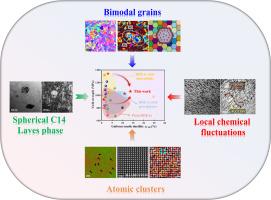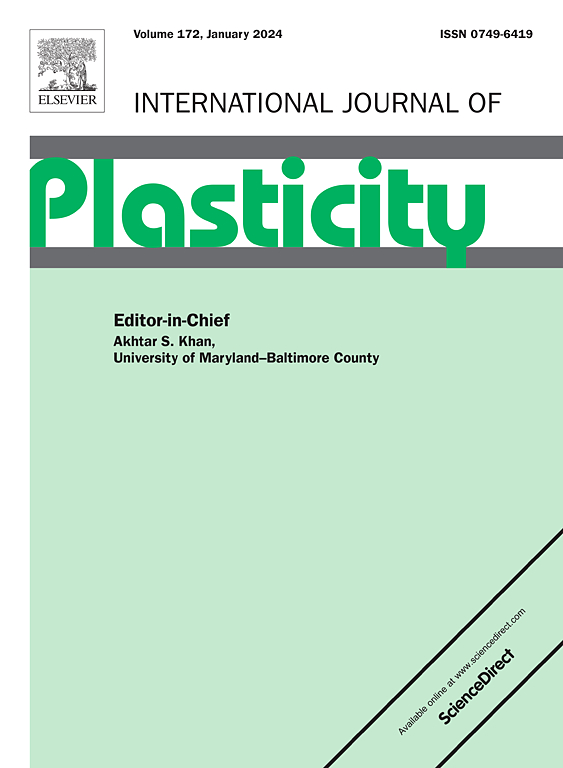采用定制多尺度异质结构策略提高轻质难熔高熵合金的应变硬化率和均匀拉伸延展性
IF 9.4
1区 材料科学
Q1 ENGINEERING, MECHANICAL
引用次数: 0
摘要
在体心立方(BCC)结构轻质耐火高熵合金(LRHEAs)变形过程中,由于低应变硬化率(SHR)导致的应变局部化导致合金过早颈缩,导致均匀拉伸延展性(UTD)较差,限制了其加工性能和适用性。在这项研究中,我们通过调整多尺度异质结构,包括微观双峰晶粒分布、亚微米球形C14 Laves相、纳米尺度局部化学波动(LCFs)和小于1nm的原子团簇,将合金的SHR从负提高到1.5 GPa。与初始均质样品相比,合金强度提高了13.8%,UTD提高了710%,整体性能优于大多数LRHEAs。双峰型晶粒界面能有效协调变形过程中两者之间的应变分布,加速几何必要位错(GNDs)的产生和储存,背应力随应变积累和增大,稳定了硬化能力。同时,精心分散的C14 Laves相在不影响塑性的前提下起到了沉淀强化的作用。矩阵的LCFs和Al-Zr原子团簇可以进一步调节统计存储位错(ssd)的形态和分布。一方面,它们可以有效地钉住位错并使其弯曲,增加ssd的迁移阻力;另一方面,微带阻塞和多滑移系统相互作用导致的位错缠结激活了新的位错源,导致次级微带以网状方式快速扩展。显著提高了塑性变形过程中的同步位错倍增率和动态位错密度,保持了合金的高持久SHR。因此,通过引入多尺度异质结构,优化GND和SSD密度和分布的协调性,可以有效提高LRHEA的SHR,从而实现强度和UTD的良好匹配。本文章由计算机程序翻译,如有差异,请以英文原文为准。


Enhancing the strain-hardening rate and uniform tensile ductility of lightweight refractory high-entropy alloys by tailoring multi-scale heterostructure strategy
During the deformation of body-centered cubic (BCC) structured lightweight refractory high-entropy alloys (LRHEAs), strain localization caused by a low strain-hardening rate (SHR) induces premature alloy necking, resulting in poor uniform tensile ductility (UTD) and restricts their processability and applicability. In this study, we improved the SHR of the alloys from negative to 1.5 GPa by tailoring multi-scale heterostructures, including the microscopic bimodal grain distribution, submicron spherical C14 Laves phase, nanoscale local chemical fluctuations (LCFs), and atomic clusters less than 1nm. The strength of the alloy was raised by 13.8 %, and the UTD increased by 710 % compared with the initial homogenized sample, and overall performance was superior to most LRHEAs. Bimodal grain interfaces can effectively coordinate the strain distribution between the two during deformation, accelerating the generation and storage of geometrically necessary dislocations (GNDs), and the back stress accumulates and increases with strain, stabilizing the hardening ability. Meanwhile, the meticulously dispersed C14 Laves phase plays a role in precipitation strengthening without compromising plasticity. The matrix's LCFs and Al-Zr atomic clusters can further regulate the morphology and distribution of statistically stored dislocations (SSDs). On the one hand, they could effectively pin dislocations and cause them to bend, increasing the migration resistance of SSDs; on the other hand, dislocation tangles resulting from microbands blocking and the interaction of multi-slip systems activate new dislocation sources, which lead to the rapid expansion of secondary microbands in a reticular manner. Those significantly increase the synchronous dislocation multiplication rate and dynamic dislocation density during plastic deformation, maintaining high and sustained SHR of alloys. Therefore, the SHR of LRHEA can be effectively improved by introducing multi-scale heterogeneous structures to optimize the coordination of GND and SSD density and distribution, thus achieving an excellent match between strength and UTD.
求助全文
通过发布文献求助,成功后即可免费获取论文全文。
去求助
来源期刊

International Journal of Plasticity
工程技术-材料科学:综合
CiteScore
15.30
自引率
26.50%
发文量
256
审稿时长
46 days
期刊介绍:
International Journal of Plasticity aims to present original research encompassing all facets of plastic deformation, damage, and fracture behavior in both isotropic and anisotropic solids. This includes exploring the thermodynamics of plasticity and fracture, continuum theory, and macroscopic as well as microscopic phenomena.
Topics of interest span the plastic behavior of single crystals and polycrystalline metals, ceramics, rocks, soils, composites, nanocrystalline and microelectronics materials, shape memory alloys, ferroelectric ceramics, thin films, and polymers. Additionally, the journal covers plasticity aspects of failure and fracture mechanics. Contributions involving significant experimental, numerical, or theoretical advancements that enhance the understanding of the plastic behavior of solids are particularly valued. Papers addressing the modeling of finite nonlinear elastic deformation, bearing similarities to the modeling of plastic deformation, are also welcomed.
 求助内容:
求助内容: 应助结果提醒方式:
应助结果提醒方式:


